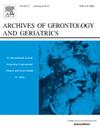体弱多病和体弱多病老年人干预措施的系统评价:来自衰弱水平临床试验的证据
IF 3.5
3区 医学
Q2 GERIATRICS & GERONTOLOGY
引用次数: 0
摘要
导言:随着全球人口寿命的延长,有必要对老年人采取有效的干预措施。虚弱前期和虚弱分别影响着 54.1% 和 26.3% 的老年人口,导致不良的身体和认知结果。本研究系统回顾了随机对照试验中针对健壮、虚弱前期和虚弱老年人的干预措施的有效性,并对虚弱程度进行了集体和单独分析。方法按照乔安娜-布里格斯研究所(JBI)的方法和PRISMA指南,检索了7个数据库中2018年至2023年间发表的研究。纳入的随机对照试验涉及年龄≥65 岁的个体。方法学质量采用PEDro量表进行评估,评分范围为7至10分,表示质量中等至高等。结果共发现3416条记录,纳入40项研究,涵盖17822名参与者(82.3%为女性,平均年龄:68-79岁)。体育锻炼干预占研究的 42.5%,多成分计划占 27.5%。32.5%的研究报告称虚弱程度有所改善,生活质量(+15.2%)、步速(+0.22米/秒)和肌肉力量(+18.7%)显著提高。讨论发现,多方面的干预措施对虚弱前期的人特别有效,这强调了制定虚弱评估标准化标准的必要性。评估方法存在地域差异和不一致。结论综合干预措施能显著提高健康和功能,尤其是对前期虚弱的老年人,这强调了早期和有针对性的方法的重要性。这项研究强调了制定标准化指南和多学科策略的必要性,以有效解决老龄人口的异质性问题。本文章由计算机程序翻译,如有差异,请以英文原文为准。
Systematic review of interventions for pre-frail and frail older adults: Evidence from clinical trials on frailty levels
Introduction
The increasing global longevity underscores the necessity of effective interventions for older adults. Pre-frailty and frailty affect 54.1 % and 26.3 % of the elderly population, respectively, leading to adverse physical and cognitive outcomes. This study systematically reviewed the effectiveness of interventions targeting robust, pre-frail, and frail older adults in randomized controlled trials, analyzing frailty levels both collectively and individually.
Methods
Following the Joanna Briggs Institute (JBI) methodology and PRISMA guidelines, seven databases were searched for studies published between 2018 and 2023. Randomized controlled trials involving individuals aged ≥65 years were included. Methodological quality was assessed using the PEDro scale, with scores ranging from 7 to 10, indicating moderate to high quality.
Results
A total of 3416 records were identified, and 40 studies were included, encompassing 17,822 participants (82.3 % women, mean age: 68–79 years). Physical exercise interventions accounted for 42.5 % of the studies, while multicomponent programs constituted 27.5 %. Improvements in frailty levels were reported in 32.5 % of the studies, with significant gains in quality of life (+15.2 %), gait speed (+0.22 m/s), and muscle strength (+18.7 %). Pre-frail individuals exhibited the greatest responsiveness to interventions, reflecting their remaining adaptability and potential for improvement.
Discussion
Multifaceted interventions were found to be particularly effective for pre-frail individuals, emphasizing the need for standardized criteria for frailty assessment. Geographic variability and inconsistencies in assessment methods were noted. Physical activity emerged as a key component in improving outcomes, with most interventions led by physiotherapists and physical education professionals.
Conclusion
Integrated interventions significantly enhance health and functionality, particularly for pre-frail older adults, underscoring the importance of early and tailored approaches. This study highlights the need for standardized guidelines and multidisciplinary strategies to address the heterogeneity of the aging population effectively.
求助全文
通过发布文献求助,成功后即可免费获取论文全文。
去求助
来源期刊
CiteScore
7.30
自引率
5.00%
发文量
198
审稿时长
16 days
期刊介绍:
Archives of Gerontology and Geriatrics provides a medium for the publication of papers from the fields of experimental gerontology and clinical and social geriatrics. The principal aim of the journal is to facilitate the exchange of information between specialists in these three fields of gerontological research. Experimental papers dealing with the basic mechanisms of aging at molecular, cellular, tissue or organ levels will be published.
Clinical papers will be accepted if they provide sufficiently new information or are of fundamental importance for the knowledge of human aging. Purely descriptive clinical papers will be accepted only if the results permit further interpretation. Papers dealing with anti-aging pharmacological preparations in humans are welcome. Papers on the social aspects of geriatrics will be accepted if they are of general interest regarding the epidemiology of aging and the efficiency and working methods of the social organizations for the health care of the elderly.

 求助内容:
求助内容: 应助结果提醒方式:
应助结果提醒方式:


